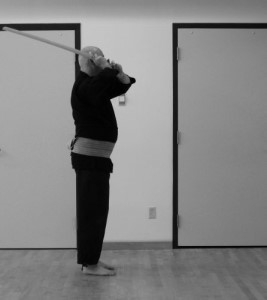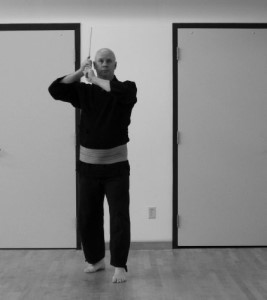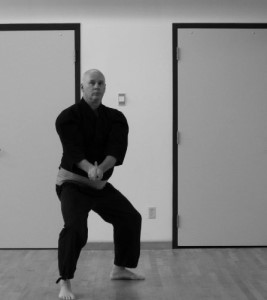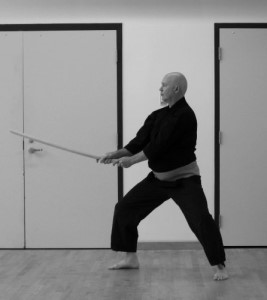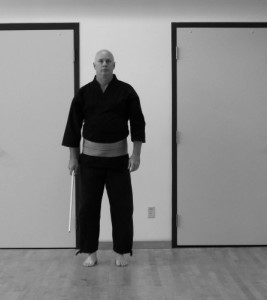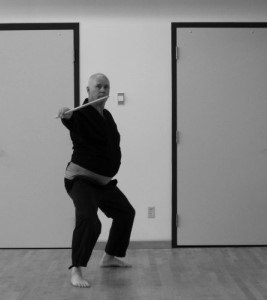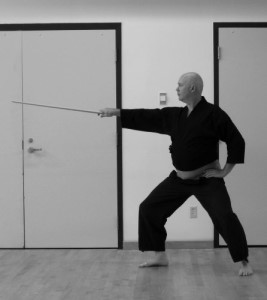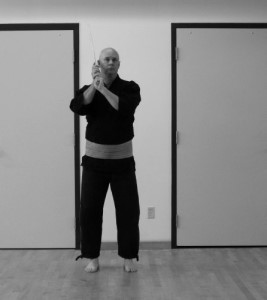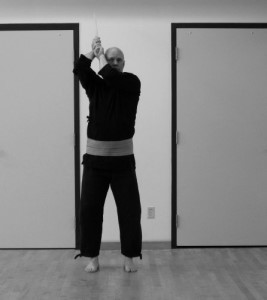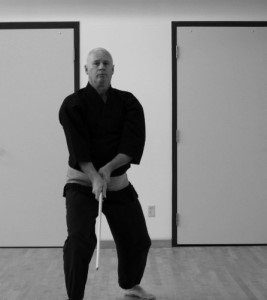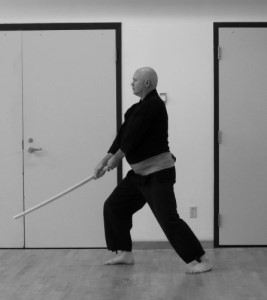Changes in Koryu:
A Case Study from Hyoho Niten Ichiryu
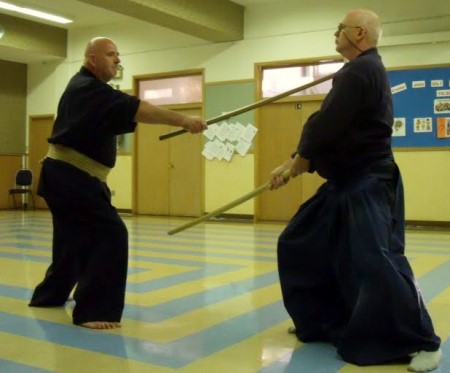 Colin Watkin and Kim Taylor: Calgary Niten SeminarPhoto by Alexander Cook
Colin Watkin and Kim Taylor: Calgary Niten SeminarPhoto by Alexander Cook
copyright
© 2009 Kim Taylor, all rights reserved
To a large extent, a
koryu represents the thought of the headmaster. The training and the
art follows his intent, his understanding and his needs. The art can
change quite dramatically within a short period if the headmaster deems
it necessary to make the change.
In this article I am going to
give my interpretation of a change in the Hyoho Niten Ichiryu training
method. These, I must warn, are my own thoughts, reflecting almost 18
years of practice in the art, but in such a way that I was left for
long periods between seminars to come to my own understanding. My
speculations were prompted by a physical change in how the techniques
are performed and I will give a history of my own practice to explain
the changes.
My introduction to Hyoho Niten Ichiryu was under
Matsuo Haruna sensei around 1992. Haruna sensei taught at the Musashi
dojo in Ohara, Okuyama which is one of the towns that claim to be the
birthplace of Miyamoto Musashi, the founder of Niten Ichiryu. Haruna
sensei practiced under three headmasters of the school, the 8th (Kikuo
Aoki sensei), 9th (Tadanao Kiyonaga sensei) and tenth (Masayuki Imai
sensei). I studied with Haruna sensei until his death several years ago
and, after a short time, had the pleasure of meeting and practicing
with the tenth headmaster, Imai sensei and his successor the 11th
headmaster Toshio Iwami sensei.
It was during the first
meeting with Imai soke that I realized the techniques had changed quite
dramatically from what I had learned. From videos of past performances,
I knew that the changes were something that Imai sensei himself had
instituted, so it was necessary for me to understand why he had done
so, rather than to simply assume that I had learned something different
from a different instructor. Unfortunately I did not have the chance to
practice more than one time with Imai sensei so I was left to my own
thoughts and those of his students.
When a student of any art
encounters changes made by very senior instructors it is necessary to
try and understand why the changes were made, rather than to turn away
from them and stick with "the traditional way" or to otherwise ignore
sensei's direction.
The changes included a drastic reduction in
the number of kata commonly practiced and changes to the techniques
themselves. I will use the very first kata, Sasen, to illustrate the
technical changes. As in many other sword schools, all of the art can
be summed up in this very first kata that a student learns. I will call
the first way I learned the kata the "old" way and the way Imai sensei
taught it the "new" way. This reflects nothing except the order in
which I learned them.
Sasen or Sashisen is a move to the right
front to avoid a downward cut, with a simultaneous thrust to the throat
of the opponent. It is performed from a one-handed gedan position and
the thrust is one handed as well.
"Old" style:
The
attacker approaches with the blade held in a hasso kamae, the elbows
wide and the forearms parallel to the floor (Fig 1-2). At a one-step
distance the attacker pauses to build tension and attacks explosively
extending the arms up and over in a full strike that comes down through
the defender's head above his left eye (Fig 3). The cut is directly
from the hasso position and does not center above the head.
The
defender is in a one handed gedan, the sword down at the right side,
the left hand down at the left side. There is a slight tightening of
the right hand to put tension in the tip of the sword and this lifts it
slightly. The tip is aimed at the attacker's left knee as they
approach. As the attacker pauses the defender gathers power in the left
foot and the tip of the sword. At the cut the defender moves
explosively to the right front, the right hand moves in a slightly
circular motion, caused by turning the blade 90 degrees so that the
edge faces the right, from the right hip to the left side of the
opponent's throat. The left hand moves up to the left hip at the same
time and the thumb comes behind the hip while the fingers stay in
front. The hips are down and the legs are long so that the shin of
the left leg is vertical, the left foot facing slightly forward. The
right knee is over the right toes and the right foot faces the target.
The power of the thrust comes in a spiral down the right arm, through
the center of balance and into the ground through the left foot.
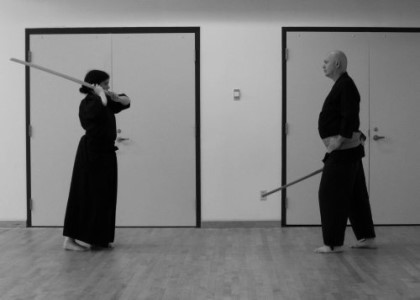 | 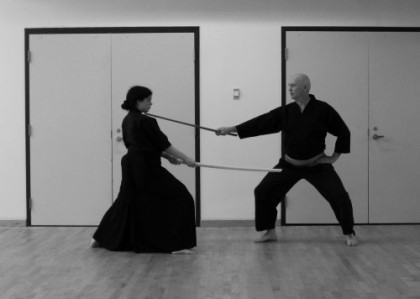 |
On
a general level, the old sasen is taught (as are many other koryu
kenjutsu), as a relaxed move to the side to avoid a strike, and a
simultaneous counterstrike.
The angle of the thrust of the old
technique is rather unusual, with the blade held sideways and the angle
of the thrust coming in a rather spiral motion from tip to left foot.
The stance is very long and the hips very low.
On the opposing
side, uchidachi (the attacking partner) moves forward in a hasso kamae
with the elbows wide, and the attacking cut is done with a large
movement and a long low stance at the finish of the cut.
New style:
For
the new sasen the attacker moves into hasso with the elbows somewhat
more relaxed than the old version (Fig 6). The wrists are then
tightened on the hilt and the bokuto is driven upward in line with the
hasso position so that the elbows move together and the arms and
shoulders are stretched upward (Fig 7). As the bokuto moves upward the
body and chest is also lifted, the stomach and hips tightened. From
this position of tension the attacker moves into a one-step distance,
pauses and then cuts explosively down onto the defender, directly from
the chambered position of the bokuto (Fig 8).
 |  |
| Fig 9 | Fig 10 |
The
defender begins in a gedan position, and then raises both hands up to
the hips while raising the chest and tightening the stomach and hips
(Fig 9). From this position the defender responds to the attacker and
moves into a one-step distance, loading the left foot and the right
hip. As the attacker cuts down the defender drives his hip to the right
front which moves his body off the line of the cut. At the same time
the defender drives the tip of the blade directly forward into the
defender's left throat while keeping the edge downward an the bokuto in
line with the right hip (Fig 10). The power of the thrust moves
straight down the bokuto, into the right hip and to the rear foot. The
rear foot is kept angled much more forward, the hips more square and
the stance shorter than the old method, which allows a further thrust
to be made if necessary, and that thrust is made as the attacker begins
his retreat to a mutual distance at the end of the kata.
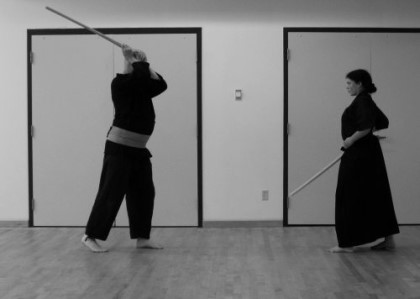 | 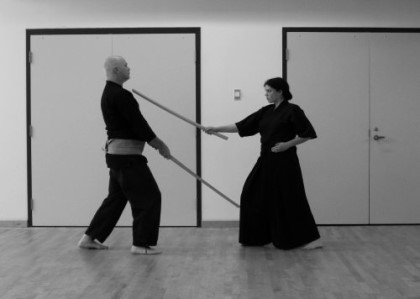 |
In
contrast, the new sasen is done from a one handed sasen which is raised
up much higher on the hip, and is done with the chest up, stomach
tight. The thrust is also now more similar to other koryu, coming
directly from the right hip with the edge down on a straight line to
the throat.
The uchidachi moves from a more or less relaxed
hasso position into an elbows in, high position which is more or less
at the top of the swing (furi kaburi), his chest is up, stomach, hips
and legs tight. The cut comes directly from this position combined with
a very strong hip movement forward and finishing with a shorter stance.
These are the technical changes in sasen, and they are
reflected in the other kata. As I mentioned, when I first met Imai
sensei he had reduced the number of techniques dramatically as well,
although they were later increased to include the entire curriculum
once more.
Why? This is the question that I now needed to
answer, why would any headmaster change the school in such a dramatic
manner? The first thing to understand is that the answer is unlikely to
have anything to do with a technically better way of defeating someone
in a sword fight. We don't fight with swords any more, and a technical
improvement (perhaps resulting from a sudden insight) in using the
sword would most likely not involve changing the way the attacking
partner used his sword too. The arts teach many things, including how
to properly use a sword, but effective sword fighting is not
necessarily high on the list of most important benefits. Again, while I
caution that what follows is my own understanding of the change, the
change is actual, so we can take it as read that koryu can change and
change dramatically in a short period of time.
I believe that
in the years prior to Imai sensei's death, the Niten Ichiryu, like many
of the koryu, had been losing students. When this happens, or when the
current students of an art have less time to practice, the number of
techniques that are regularly studied is reduced. At the same time,
those students who are left need to be brought along more quickly or
need to reach a high performance level quickly for when embu are
presented.
This may explain the reduced study set but why the
changes to the techniques? Without actually practicing the new
techniques it would be difficult to understand their effects. In a
nutshell, what I noticed almost immediately is that the new practice
method uses changes in body position in such a way as to create an
adrenalin dump. This physiological effect brings students to a very
high pitch very quickly, so quickly that at that first seminar I hit a
long-time training partner square on the head and the only thing in my
mind was "YES! Got him!".
How does this happen? As I
mentioned, the new method is quite different from the old, and from
many other sword arts. The weight is carried high, the chest up and
forward, the stomach and hips are tightened This makes the breathing
shallow and high in the chest which creates a feeling of anxiety. Most
martial arts strive to make the student calm by deep breathing and
relaxed shoulders. The move from hasso into a higher ready position for
the attacker means that a feeling of tension is created which is
released very suddenly at the defender. The defender must also move to
the same high pitch of readiness in order to avoid being hit. The
entire process means that adrenalin pours into the system and practice
becomes very tiring even if it's only a short one. It is not
uncommon to leave a short practice with the arms and legs shaking.
The
stances in the new method are also shorter and more square, more, if I
may say it, Kendo-like compared to the older koshimi position which was
deep and long, a final movement. The shorter stance implies that the
fight may continue, or that other attackers may appear. The longer
stance assumes that the fight has reached a place of some space, if not
the finish.
Finally, the thrust change has come about, I
believe, because the older style is more difficult to perform quickly
and more or less requires the long finishing stance. The more direct
new thrust means the technique can be done within the time of the
shorter attacking cut.
Have these changes brought about their
intended result? Are there now more students in the art? I would think
that the answer is yes, there are now many students in the west who are
actively studying under Iwami soke and other instructors of the school.
Will the old style of training eventually be practiced again? That I do
not know, it is entirely the decision of the current headmaster who
will make his decisions according to his own assesment of the needs of
the art, the students and his own understanding of Hyoho Niten Ichiryu.
In
this small article I have attempted to demonstrate that the koryu do
indeed change, and I have given my understanding of why a major change
in one koryu has come about through the decision of a headmaster who
was responding to the needs of his art.
Our
Sponsor, SDKsupplies


